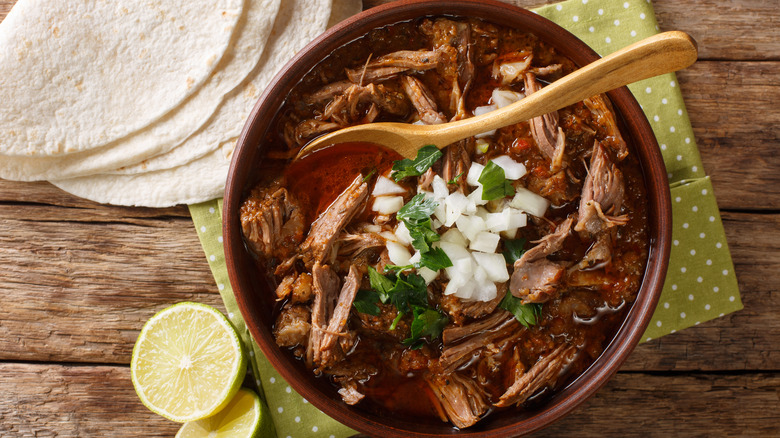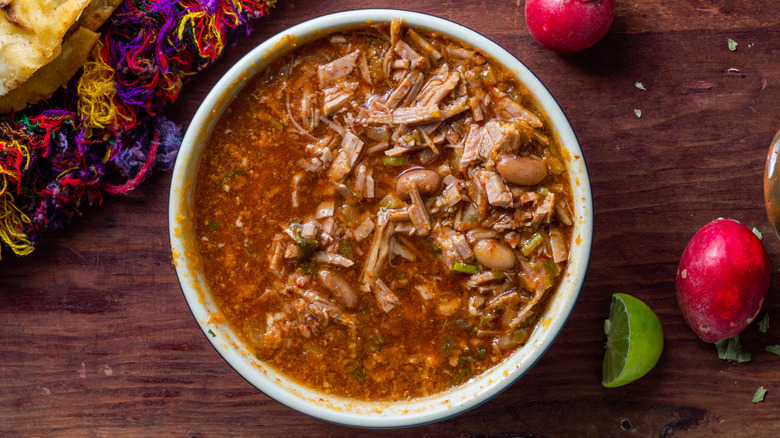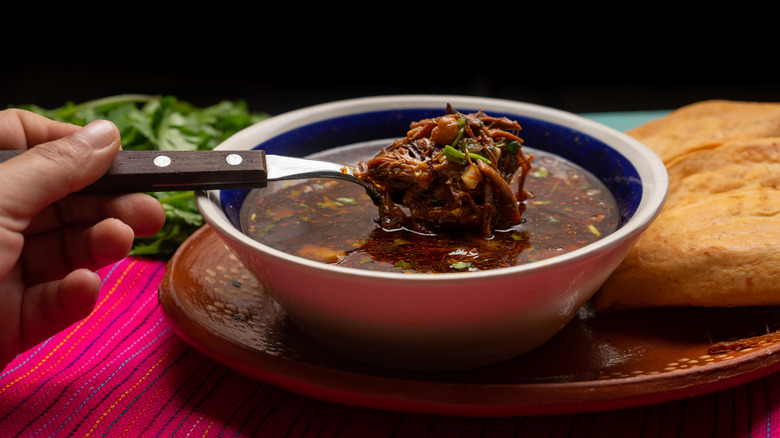For The Most Authentic Version Of Birria, Lose The Taco Shells
A decade ago, you'd be hard-pressed to find birria on most Mexican menus in the U.S. The dish didn't truly have its day stateside until a few years ago,when it became a major food trend. Now, this regional gem of Mexican cuisine is widely available as mouthwatering tacos (sometimes crunchy and cheesy, too) at restaurants all over the country. However, for the most authentic birria, you need not eat a taco at all. Rather, in Jalisco, Mexico, the tequila capital of the world, you can enjoy it as a stew traditionally made with goat meat.
Birria employs a different method of cooking meat than, say, al pastor and its spinning trompo rotisserie. Instead of dry, direct heat, the meat typically braises in broth, soaking up those long-simmered flavors and becoming unbelievably tender. In the U.S., we mostly see that broth in the form of consommé that is used for dunking. When you order birria tacos, you usually get a cup of it on the side, similar to the au jus that comes with a French dip. But in Jalisco, the stew often speaks for itself; think of it as eating a bowl of that rich, savory consommé, with tortillas as an afterthought.
Jalisco, Mexico is birria's birthplace
In Jalisco, a state on Mexico's western coast, the stew originated as a means of survival. The concept of birria has been around for more than half a century, starting in the 16th century, when Indigenous groups were forced to eat goat meat to keep from going hungry. The downside to cooking goat is that it's so lean, which can make it a bit tough (it's an often-overlooked meat for this reason), so they needed a cooking method that would tenderize it as much as possible.
Local Indigenous cooks developed birria, which comes from a Spanish phrase meaning "no value" because it was an inexpensive, resourceful way for people to eat. Covering the goat meat in broth allowed it to cook low and slow, creating a tender and palatable dish. The broth and meat were then served together in stew form alongside rice, bread, or tortillas, making for a more fortifying meal.
Of course, birria broth also flavors the meat as it cooks, giving it depth and richness. The stew base calls for an extensive assortment of ingredients, though today, the recipe differs depending on who is preparing it. Typically, the broth is made with plenty of peppers, including ancho and guajillo chiles, as well as seasonings such as cloves, cinnamon, cumin, and garlic. Tomatoes and onions are added, too, for additional flavor.
Jalisco's birria won't get your goat
To make the goat as tender as possible, the meat requires several hours of cooking in the broth. In an episode of Rick Martinez's YouTube show "Pruébalo," Martinez and Jaliscan-born birria maker Juan Garcia of The Goat Mafia prepare the dish together. They start by marinating the goat meat in a mix of orange juice and seasonings, including plenty of chiles, that have been blended and thickened with animal crackers. Whole green onions are added to the pot, and from there, the marinated goat meat cooks in a clay pot inside an oven for around five hours.
Garcia notes that the consommé at some birria establishments in Jalisco is clear, but it can also be a deep red. The clear color has to do with the broth likely being vinegar-based, though not all birria broth is made this way. Some Jaliscan birria is served with the goat testicles and innards as well as the meat, but it once again depends on the birria maker's recipe. When asked why making birria was important to him, Garcia noted that he wanted to preserve the dish. "This dish is part of my family," the fourth-generation birriero told Martinez.


